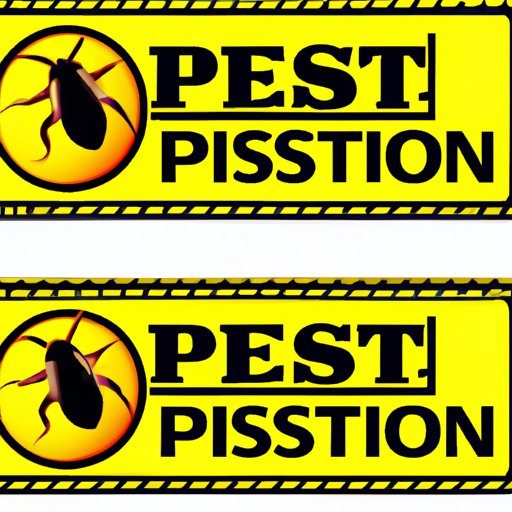I. Introduction
As a homeowner, ensuring your property is free from pests is essential. A pest infestation can cause significant damage while also creating health hazards that can harm you and your family. Identifying the signs of a pest infestation early can help prevent further damage, and potentially save you thousands of dollars in repair costs. In this article, we’ll guide you through the common symptoms associated with different types of pests, how to detect infestations and their warning signs, how to take action when you identify an infestation, and offer tips to prevent future infestations.
II. Symptoms of a Pest Infestation: A Guide for Homeowners
Several pests commonly infest homes. These include rodents, termites, bed bugs, roaches, and ants. Knowing what pests to look for is the first step in identifying a pest infestation. Each type of pest infestation exhibits its own symptoms, including odor, excrement, and structural damage.
Rodents such as rats and mice can cause destruction by chewing through wood, insulation, and electrical wires. They can also cause significant health hazards by transmitting disease. Watch out for rodent droppings, gnawed objects, smudge marks, and urine stains.
Termites can cause extensive damage to your home’s structure if left untreated. Watch out for termite tubes, wood that sounds hollow when tapped, and piles of fecal pellets that resemble tiny wood shavings.
Bed bugs can be challenging to detect, but signs include bites on your body, tiny bloodstains on your sheets, and rust-colored stains on your bedding.
Roaches and ants are attracted to food, and their infestations can often be found in kitchens and eating areas. Signs of an infestation include an unpleasant, musty odor, droppings, and grease marks on walls or surfaces.
III. How to Detect Pest Infestation: Warning Signs to Look Out For
Identifying warning signs of a pest infestation can help you detect the earliest stages of an infestation. Early detection can significantly reduce the damage caused and allow you to address the issue promptly.
Common signs of pest infestation include:
– Damaged walls, wires, and insulation
– Visible fecal matter and urine stains
– Strong odor
– Piles of debris, including wings, fecal matter, and dead bugs
– Nesting materials
– Scratching noises, especially at night
– Live or dead pests
If you observe any of these signs, it is essential to contact a pest control specialist immediately. Trained specialists can help identify the specific pest causing the infestation and determine the most effective treatment.
IV. The Telltale Signs of a Pest Infestation
While some signs of a pest infestation are well-known to homeowners, others may not be as apparent. Some common, yet surprising, signs of a pest infestation include chewed cables and wires, unusual odors, and tunneling sounds in the walls.
Ignoring persistent signs of a pest infestation can lead to dire consequences, including damage to your property, health hazards, and costly repairs.
V. An Expert Shares Tips on Identifying Pest Infestations in Your Home
To provide further insights, we interviewed a pest control specialist to offer tips and advice for homeowners. They suggest starting with a thorough inspection of your home, checking for any signs of damage or pest activity.
Specialists also suggest being mindful of your home’s exterior, sealing any cracks or crevices, and reducing clutter where possible. Additionally, homeowners can use natural methods to repel pests, such as using essential oils or herbs that rodents and insects find unattractive.
VI. Don’t Ignore These Signs of Pest Infestations in Your Home
Ignoring the signs of a pest infestation can lead to spreading the infestation, breeding of the pests, and additional damage to your home and health. Call a pest control specialist upon first detection of signs like droppings, urine stains, gnaw marks, and rust-colored spots.
Prevention is always better than cure, and there are several steps homeowners can take to deter pests from invading their homes. Such measures include keeping food in sealed containers, regularly cleaning your home, eliminating areas of standing moisture, and avoiding clutter.
VII. Recognizing the Signs of a Pest Infestation: What Every Homeowner Needs to Know
In summary, recognizing the signs of a pest infestation is essential for every homeowner. The various types of pests that frequently infest homes have different signs, and early detection is critical in reducing the damage caused and treating the infestation effectively.
To guard your home against pests, focus on prevention by following some steps we’ve highlighted above, such as maintaining cleanliness, proper moisture control, and sealing all entry points to avoid any possible access by pests.
VIII. Conclusion
Pests are more than just a nuisance. If not detected early on, an infestation can cause significant damage to your home and pose a severe health hazard to you and your family. Being aware of the signs of infestation and staying vigilant can help you take prompt action upon the detection of any pest activity and save you both money and time.
Don’t hesitate to contact a pest control specialist if you suspect an infestation, and always prioritize preventive measures to avoid future infestations.
